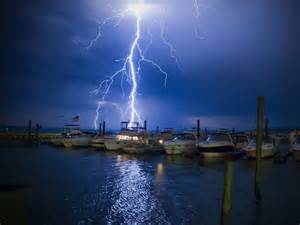
Stay Safe in a Thunderstorm
We all learn in grade school that lightning seeks the highest point, and on the water that’s the top of the boat — typically a mast, antenna, Bimini top, fishing rod in a vertical rod holder or even the tallest person in an open boat. If possible, find a protected area out of the wind and drop anchor. If the boat has an enclosed cabin, people should be directed to go inside and stay well away from metal objects, electrical outlets and appliances (it’s a good idea to don life jackets too). Side flashes can jump from metal objects to other objects — even bodies — as they seek a path to water.
Under no circumstances should the VHF radio be used during an electrical storm unless it’s an emergency (handhelds are OK). Also, be careful not to grab two metal objects, like a metal steering wheel and metal railing — that can be a deadly spot to be if there’s a strike. Some boaters opt to steer with a wooden spoon and keep their other hand in a pocket if forced to man the helm during a storm, while others like to wear rubber gloves for insulation.
Protection
A conventional lightning-protection system consists of an air terminal (lightning rod) above the boat connected to a thick wire run down to an underwater metal ground plate attached to the hull — large metal objects like tanks, engines and rails are also connected. New studies suggest multiple terminals and multiple ground paths work better.
An open boat like a runabout is the most dangerous to human life during lightning storms, since you are the highest point and most likely to get hit if the boat is struck. If shore is out of reach, the advice is to drop anchor, remove all metal jewelry, put on life jackets and get low in the center of the boat. Definitely stay out of the water and stow the fishing rods.
If all goes well, the storm will blow past or rain itself out in 20 to 30 minutes. It’s best to wait at least 30 minutes until after the last clap of thunder to resume activities.
There’s a Zap For That
A smartphone coupled with real-time National Oceanic and Atmospheric Administration (NOAA) lightning tracking information can make a powerful tool for avoiding storms. Some apps will even notify you if there is a strike near any of your designated areas. Do an Internet search for “lightning app NOAA” — there are a number of iPhone and Android apps available. A little early warning could give you just the time you need to make it back to shore and seek shelter.
Hit!
Knowing what to do in a storm and having the best lightning-protection system installed on the boat is by no means a guarantee that lightning won’t strike.
The immediate checklist for a direct hit is very short:
- Check for unconscious or injured persons first. If they’re moving and breathing, they’ll likely be OK. Immediately begin CPR on unconscious victims if a pulse and/or breathing is absent — there’s no danger of being shocked by someone just struck by lightning.
- In the meantime, have someone check the bilges for water. It’s rare, but lightning can blow out a transducer or through-hull — or even just blow a hole in the boat. Plug the hole, get the bilge pumps running, work the bail bucket — whatever it takes to stay afloat. An emergency call on the VHF is warranted if the situation is dire. If the radio is toast, break out the flare kit.
Lightning seeks the highest point, and on the water that's the top of the boat.
If there are no injuries and no holes or major leaks below, just continue to wait it out. Once the danger has passed, check the operation of the engine and all electronics. Even a near strike can fry electronics and an engine’s electronic control unit, cutting off navigation, communication and even propulsion. Some boaters stash charged handheld VHF and GPS units and a spare engine ECU in the microwave or a tin box for this very reason. These makeshift Faraday cages have saved equipment.
Obvious damage will need to be assessed and set right. Even those lucky enough to come away completely unscathed after lighting storms, with no apparent damage should have a professional survey done just to be sure. Minor damage to through-hulls can result in slow leaks, and all manner of electrical wackiness can emerge — sometimes much later. It’s best to catch these issues right away and get that information to the insurance folks for coverage.
Is Just a Ground Plate Enough?
An immersed 1-square-foot ground plate with hard edges creates a low-resistance path for lightning current to flow through (instead of through the boat or its crew!). But expert Dr. Ewen Thomson) believes multiple rods and near-water electrodes provide better protection.
Take it from a luxury trawler owner who sustained more than $1 million in damage from a strike: “Boat insurance turns out to be the best investment we have made in the past 10 years!” he said. “We will never again grumble about writing a check for an insurance premium.”